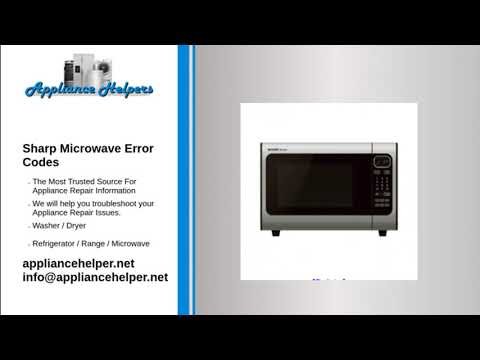
Microwaves have become an indispensable part of our kitchens. They speed up our cooking, heat our leftovers, and make life a bit simpler. But like any other appliance, they can run into problems. The “Oe” error code is the microwave’s way of telling you something isn’t quite right. It’s like a cryptic message that’s trying to communicate an issue without directly saying, “Hey, pay attention here!”
Decoding the “Oe” Error Code
When your Sharp microwave displays an “Oe” error code, it’s signaling a problem with the oven sensor circuit. Think of the sensor as the microwave’s way of checking its own vital signs. If it’s not working properly, it can’t correctly regulate the cooking temperature.
Here’s the deal: This sensor malfunction isn’t something that will make your microwave explode, so you don’t need to panic. However, it can lead to uneven cooking or even stop the microwave from working altogether. Imagine trying to bake cookies in an oven that can’t tell if it’s hot enough. They might end up raw in the middle or burnt to a crisp. That’s the kind of thing that can happen with your food in the microwave if the sensor isn’t doing its job.
So, what causes this sneaky error to appear? Well, it could be due to a faulty sensor, a loose wire connection, or even a glitch in the microwave’s electronic control board. It’s like when your phone doesn’t charge because there’s lint in the charging port or the cable is frayed. Simple issues that can cause big headaches, right?
Is It Safe to Continue Using the Microwave?
You might be wondering if you should keep using your microwave or if it’s time to unplug it and call in the experts. The safety of continuing to use a microwave with an “Oe” error largely depends on the problem’s severity.
Now, if your microwave is still functioning and heating your food despite the error code, it’s not an immediate safety hazard. However, there’s a catch. You might experience inconsistent heating results, where some parts of your food are piping hot while others are still cold. This might not seem like a big deal, but it’s not ideal for food safety, as certain areas could harbor bacteria if not cooked properly.
On the flip side, if the microwave stops working altogether or you notice any unusual smells or sounds, it’s time to stop using it. The broken sensor could lead to overheating or cause further damage to other components, much like how ignoring a small oil leak in your car could eventually lead to engine trouble.
Next steps? It’s a good idea to have a professional take a look at it. A qualified technician can diagnose the root cause and suggest a suitable fix.
How to Troubleshoot and Possibly Fix the Issue
Before you call up a repair service, there are a few things you can try at home to potentially resolve the issue. First, it’s always a smart move to reset the appliance. Unplug your microwave, wait about 10 minutes, and then plug it back in. This is akin to rebooting a computer to clear minor software glitches.
If the error persists, it’s time to get a little more hands-on. Safely slide your microwave out from the cabinet or shelf it’s perched on, and inspect the connections. A loose connection might be the sneaky culprit here. Double-check that all the wires are securely attached, especially those leading to the sensor.
However, if poking around the guts of a microwave sounds a bit too daunting, it’s totally fine to skip this step. You wouldn’t try to fix your phone’s motherboard on your own, right?
Preventing Future Errors and Ensuring Longevity
Keeping your microwave in tip-top shape helps prevent error codes from popping up and extends its lifespan. One simple yet effective tip is to regularly clean it. Food splatters can get into vents and other openings, which might affect the internal components. It’s like keeping your car’s windshield clean for better visibility.
Moreover, avoid slamming the microwave door or yanking on the power cord, as these actions can damage the sensor and wiring. Treat these parts gently, just as you would when handling fragile glassware.
If you find that the error code repeats often, even after professional repairs, it might be time to consider an upgrade. Just like how replacing an old computer can solve ongoing issues, a new microwave with modern features and efficiency could save you time and trouble in the long run.
In conclusion, while a Sharp microwave with an “Oe” error isn’t an emergency, it is a signal to pay attention. With a little troubleshooting and care, you can keep your appliance running smoothly or decide it’s time for a change. Either way, your microwave can continue to be that convenient kitchen companion you rely on every day.